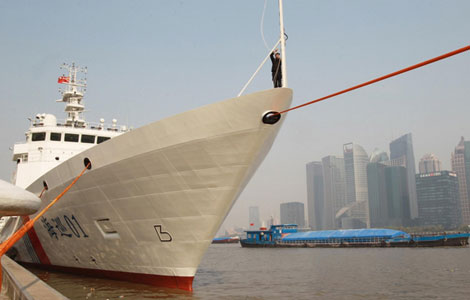Indeed a fruitful outcome
Updated: 2013-07-15 07:13
By Tao Wenzhao (China Daily)
|
||||||||
As the most important China-US consultation and cooperation mechanism, the S&ED has succeeded in opening new avenues
The just concluded fifth round of annual Strategic and Economic Dialogue between China and the United States was successful to say the least. Among its achievements are 91 specific agreements on the strategic front. But there is more to the fifth S&ED than just the positive outcomes.
First, the dialogue was a logical follow-up of the talks between President Xi Jinping and his US counterpart Barack Obama at Sunnylands, California, in June where they agreed to build a new type of major power relationship between the two countries. At the just-concluded S&ED, the two countries vowed to take concrete measures to give shape to the agreement reached between the two heads of state, and emphasized the importance of expanding and deepening cooperation, and narrowing differences to ensure that bilateral relations benefit the two peoples.
An important feature of the new relationship is no conflict, no confrontation. Since confrontations and conflicts have their roots in differences, it is important to properly manage them. In fact, if differences are correctly handled, they can be turned into opportunities for cooperation.
For example, after former National Security Agency operative Edward Snowden exposed Washington's surveillance program, the two sides did not point the finger at each other and, instead, held candid and constructive discussions, and agreed to hold more talks on international norms to manage cyberspace. This is a good start.
Second, that the Strategic Security Dialogue and the first Cyber Working Group meeting - marked by one-on-one discussions - were held along with the fifth S&ED shows that the two countries are keen on managing bilateral relations with an eye on long-term benefits. The S&ED is the most important of the more than 90 mechanisms for consultation and cooperation between the two countries, and a guideline for one-on-one talks. In other words, one-on-one mechanisms are meant to implement the results of the S&ED.
Third, the two sides reached a consensus on a number of important issues. For example, they have agreed to start discussion on China-US Bilateral Investment Treaty, which had not seen much progress over the past nine years, and the US also promised to offer an open investment environment for Chinese enterprises.
Besides, the two countries have decided to actively explore the possibility of setting up a mechanism to inform each other of their major military activities and to continue talks on the rules of behavior on military, including maritime, activities. This is a major step forward because military-to-military relations will help build strategic mutual trust. By exploring the possibility of setting up a notification mechanism for major military activities, the two sides are trying to make their military-to-military relations an integral part of bilateral relations in their effort to build a new type of major power relationship.
The two countries have also decided to establish a hotline between the special representatives of their presidents to facilitate smoother and uninterrupted bilateral communication, which is necessary given the importance of their relationship. The need now is for the two sides to continue their talks on all fronts, let each other know their intentions, enhance mutual trust and avoid misunderstandings.
The other important areas that the two countries agreed to cooperate in are climate change and energy security, and transparency, which is a step in the right direction to improve bilateral relations.
Fourth, the S&ED covered all major global issues reflecting the responsibilities China and the US shoulder in global governance. To overcome the global financial crisis, the US introduced the quantitative easing (QE) policy, but now it has decided to taper it off. Since Washington's policies have a significant impact on the global financial market, global economic recovery and emerging economies, China has welcomed the withdrawal of QE but suggested that the Federal Reserve properly handle its timing, tempo and intensity to ensure that the rest of the world does not suffer its consequences.
But just one dialogue cannot solve all the problems. The two sides still differ on some issues, and continuous communication is needed to narrow them. In some regional issues, for instance, China has been urging the US to respect the facts, do what it says and refrain from doing something that could further complicate the issues. Moreover, the US is yet to fulfill its promise of easing restrictions on high-tech exports to China. Also, China is waiting for the US to consider its request to be treated fairly as Washington reforms its export control system.
But generally speaking, the S&ED has achieved the expected goals and is an important step forward toward building a new type of major power relationship.
The author is a senior researcher at the Center for US-China Relations at Tsinghua University.
(China Daily 07/15/2013 page8)

 Protests erupt after verdict
Protests erupt after verdict
 Color Run in London promotes healthy living
Color Run in London promotes healthy living
 Urumqi residents hand in weapons
Urumqi residents hand in weapons
 Pool jammed in summer heat
Pool jammed in summer heat
 Last stop for the telegrams of India
Last stop for the telegrams of India
 Heavy rain, strong winds as Soulik heads inland
Heavy rain, strong winds as Soulik heads inland
 8 dead, 19 injured after bus leaves road in Jinghong
8 dead, 19 injured after bus leaves road in Jinghong
 China's largest salvage vessel visits Indonesia
China's largest salvage vessel visits Indonesia
Most Viewed
Editor's Picks

|

|

|

|

|

|
Today's Top News
Snowden says he won't release harmful US data
Local governments face financing woes
Zimmerman not guilty
More foreign firms in IPR cases
Urumqi residents hand in weapons
Largest vessel visits Indonesia
HK to lift controls on baby formula
Typhoon Soulik kills 3 in S China
US Weekly

|

|







